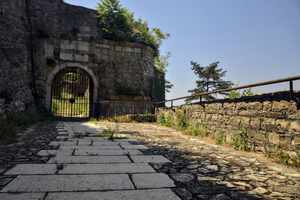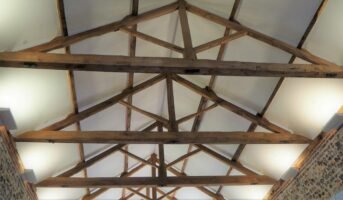Breast walls are built to prevent newly cut slopes on steep hillside embankments from rolling down the hill as a result of bad weather conditions, such as sliding and land erosion. The sturdiness of the road can be impacted in hilly areas by the inclinations and slicing slopes of the hillside.
In hilly regions with minor slips and slides during rain, travel is restricted. You may have travelled through hilly places where, when it rains, small stones and other debris are often spread across the road. Such a condition seems too dangerous and unsafe. Utilising a breast wall is one method of preventing these minor slope fragment slips and slides. It is the most cost-effective method of shielding the slope’s toe from the road shoulder’s edge.
Designers account for situations where there is a possibility of slipping or sliding on the road by including provisions like the breast wall. The usual breast wall height is 3 metres, and it is constructed of masonry stonework placed in concrete mortar.
What is a breast wall?
Engineers build a wall at the downstream end of the embankment known as the breast wall to support and hold the naturally occurring slope of the earth at the hill face. This wall serves as a barrier against slippage failure, erosion, and land-sliding on the slope.
Breast wall: Advantages
When it comes to the edges of hillsides during construction projects, a breast wall is utilised for numerous purposes, including cutting the mountain’s edges and making a road route through it. The breast wall has the following benefits:
- As a result meteorological factors including erosion, heavy rain, and other factors, prevent soil on a natural barrier gradient from rolling down.
- It is also appropriate for Hydraulic structural components.
- It somewhat aids in the prevention of natural disasters like landslides and slope failures.
- It is cost-effective.
- With indigenous labour and resources, construction can be completed.
- Motorists’ safety has improved as a result.
Breast wall: Disadvantages
Although the breast wall is a cost-effective solution for sliding issues in mountainous places, it still has several drawbacks.
- To retain geologically unstable or fractured rock or soil slope, a breast wall can’t be used.
- It can only prevent small landslides and is ineffective at preventing larger landslides that carry a higher surcharge load.
- The breast wall requires too much maintenance. During rainy seasons, you may experience issues with the wall tilting and weep holes becoming blocked.
Breast wall: Uses
A modest stone wall used to preserve the natural earthen bank is called a breast wall.
- A geological hillside’s freshly cut or old natural surface and the road are separated from one another by this style of wall.
- To prevent mountain landslides, it is mostly taken into consideration in regions where the climate and rainfall pour over the grade of the hill.
- Moreover, it prevents unforeseen soil slips.
- It is used at the edge of the streets to maintain the appearance of a natural earthen embankment.
- Along riverbanks, it is used to keep the surrounding dirt in place.
How to design a breast wall?
When choosing the foundation or plan for the design’s implementation, many aspects of the breast wall design must be taken into consideration, for instance:
- The breast wall needs a broader base due to the amount the earth surcharges. The breast wall should not be taller than three metres because of the increased risk of sliding and toppling.
- A breast wall’s design is influenced by several variables, including the minimum required wall height, the strength of the supporting structure, and the slope of the excavation.
- Weep apertures need to be built up often to lessen the saturated soil tension at the barrier.
- It is expected that the thrusting or ground pressure will apply pressure in a direction parallel to the breast wall.
Where is breast wall provided?
Breast walls are usually stone masonry barriers created to protect naturally occurring land-cutting gradients from the environment and unstable carved slopes, but not from the power of snowy avalanches. A toe wall cannot sustain an uneven slope. To prevent damage during construction or on regular days, it is typically offered on the downstream side of the roadways that are close to any hilly or mountainous places. A breast wall on the cut slope edge with a significant negative batter considerably reduces the earth pressure. Therefore, if the breast wall is placed on a rock or other hard natural soil, even a little section of it can sustain cut gradients in the soil.
Breast wall design calculation
To determine the total wave force impacting the breast wall at a wave peak, apply the formula below.
Cp=0.24γHKp
Where KP stands for the ordinary pressure coefficient for a non-dimensional variable and Cp represents the overall wave pressure in kPa. The actual height of the wave is h, whereas “M” denotes the surge amplitude.
How is breast wall different from retaining wall?
Many civil engineers are unable to distinguish between a breast wall and a retaining wall. However, these two structures are distinct from one another in terms of their function and design objectives.
Generally speaking, the breast wall is a smaller structure than the retaining wall. Only breast walls shorter than three metres should be used, for this reason. In hilly regions, breast walls just withstand pressure from newly cut earth.
The retaining wall is made to withstand the pressure of both the backfill and the road. However, a breast wall only bears the load of a retained sloping surcharge.
A retaining wall that is constructed at an elevation lower than the road level can be seen in a typical configuration or cross-section of a road. The wall that is built above the level of the road is called the breast wall.
The main difference between a retaining wall and breast wall is the fact that the retaining walls are built at upstream of a road formation while breast walls are built at their downstream.
What is a retaining wall?
Retaining walls are walls constructed for supporting the earth against its back. The ground cannot stay in vertical position but will be in equilibrium when it takes a natural angle called the angle of repose. The portion of the earth that needs to be in vertical position must be supported by the retaining wall.
FAQs
Which type of wall is strongest?
The retaining wall's interlocking concrete blocks provide exceptional strength, structure, and stability. They have an exceptional level of durability and typically last for a century or longer.
How is the breast wall constructed?
A surface terrace is formed by joining several rectangular breast wall panels into rows to create a breast wall construction. Stones, broken stones, gravel, and other materials are used to fill the spaces between the breast wall panels and the slope's natural slope.
Where are toe walls used?
A low wall is constructed at the bottom of an embankment to prevent slippage or spreading of the soil.
Retaining Wall vs Breast Wall, which is Better?
We have determined after analysis that each wall has its purpose. Because they both play a vital role in maintaining the earth, we cannot compare the two.
Where does the breast wall typically exist?
A low wall is constructed at the bottom of an embankment to prevent soil from slipping or spreading.
Housing News Desk is the news desk of leading online real estate portal, Housing.com. Housing News Desk focuses on a variety of topics such as real estate laws, taxes, current news, property trends, home loans, rentals, décor, green homes, home improvement, etc. The main objective of the news desk, is to cover the real estate sector from the perspective of providing information that is useful to the end-user.
Facebook: https://www.facebook.com/housing.com/
Twitter: https://twitter.com/Housing
Email: editor@housing.com












